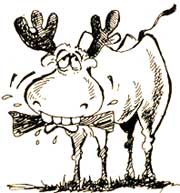Chemical battles
 THE "arms race" between plants that produce defence mechanisms to ward of foragers such as deer and animals who attempt to evolve mechanisms to counter these defences, have long intrigued evolutionary biologists.
THE "arms race" between plants that produce defence mechanisms to ward of foragers such as deer and animals who attempt to evolve mechanisms to counter these defences, have long intrigued evolutionary biologists.
Scientists say the moose (Alces alces), a large herbivorous mammal found in temperate regions, appears to be leading (Trends in Ecology and Evolution, Vol. 7, No. 1), because it can survive on birches, which have low nutritive quality, and it has a digestive system that can deal efficiently with plant toxins. Its choice of forage is determined by the amount available and its energy content.
However, plants have not simply withered and given up the fight. Toxic compounds reduce the amount of plans that a moose can eat, totally excluding some plant species from its diet and modifying the choice of its feeding habitat.
Related Content
- Order of the National Green Tribunal regarding chemical waste of 337 metric tons lying the Union Carbide campus contaminating groundwater, 20/03/2024
- Chemicals factory blast injures 12 outside Cairo's main airport
- Pune: Environment-conscious citizens at forefront of battle against plastic waste
- Napoleon' bug that could help do battle against water pollution in China
- Green crusaders, agriculture innovators battle 'unscientific' tag
- Budget 2013-2014: speech of P. Chidambaram, Minister of Finance
